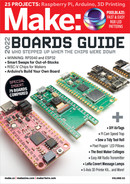
LEDs make everything better, but sometimes
it’s hard to get all the information you need to
make the super-cool light-up costume of your
dreams. Today, we’ll go from basics to pixel
mapping! One of my favorite things about LEDs
is that they’re a gateway to creating all kinds of
fashion and accessories, like the responsive LED
umbrella tutorial I’ll share here.
THE BASICS
There are countless shapes of LEDs, but we
can start with the two types of packaging you’ll
encounter: through-hole technology (THT) and
surface mount technology (SMT). These each come
in multiple sizes, shapes, and form factors. You’re
probably most familiar with a through-hole LED
(Figure
A
), which (usually) has two legs, and LED
strips, which are how we most often see SMT
components, soldered flat onto them.
All LEDs are polarized components, meaning
that they have a positive and negative lead. By
applying a specific voltage to the positive leg, and
connecting the negative leg to ground, we can
turn on the LED! No matter the shape or size or
color, at their core, they’re all working like this. I’ll
go over a few configurations.
Often people get started with LEDs by hooking
up a 3mm through-hole LED to a CR3032 coin cell
battery (Figure
B
), making a “throwie” (makezine.
com/projects/Extreme-LED-Throwies). They’re so
much fun — add a coin-shaped magnet to make
them stick to stuff when you throw them!In a
basic through-hole LED, the longer leg is usually
positive and the shorter one is negative. I like to
remember this by reminding myself that I want
“more positivity” (or less negativity?) — because
keeping track of the polarity is very important.
If you’ve already twisted, trimmed, or soldered
the legs of your LED, sometimes through-hole
Dushan Milic, Kirk von Rohr / Make:
+ -
B
LEDs are big enough to look inside and see that
each leg is connected to a piece of metal, and one
piece is hanging over the other. The one hanging
over is the negative leg — because “hangovers
are negative.” Easy to remember!
Now, all through-hole LEDs aren’t created
equal. Every green LED you buy won’t give the
same color of green light, because of a variety of
factors including the materials used to produce
the LED, or the shape of the epoxy lens. Some
have tinted epoxy casings, some are 3mm,
5mm, or even 10mm in diameter, and some cast
different shadows or have different light qualities. I
find the LEDs with clear epoxy to be the brightest;
they’re often labeled “super bright.” You can find
LEDs in a variety of shapes — dome, square,
cylindrical — which can be useful depending what
you’re doing, but some of my favorites are the
dLUX-dLITE LEDs by Unexpected Labs, which
come in all kinds of cool shapes from skulls to
spikes to spheres (Figure
C
).
You won't find LEDs in every single color, but
thanks to additive color theory, you can mix two
or more LEDs to get the color you want. Red and
green make yellow, green and blue make cyan,
blue and red make magenta. By mixing different
amounts of these, you can achieve the full color
spectrum.
RGB LEDs are full-color LEDs which have four
legs, one each for red, green, blue, and ground.
These are basically three small LEDs in a single
package, and you can make any color by mixing
different amounts of each color (Figure
D
).
IDENTIFYING LEDS
If you want to add more than a few LEDs, you’ll
need to look into other form factors, such as
panels and most commonly LED strips. This is
where things get a bit tricky, and some vocabulary
A C D
71
make.co
M83_070-75_SquishyLee_F1.indd 71M83_070-75_SquishyLee_F1.indd 71 10/10/22 3:51 PM10/10/22 3:51 PM
..................Content has been hidden....................
You can't read the all page of ebook, please click here login for view all page.
